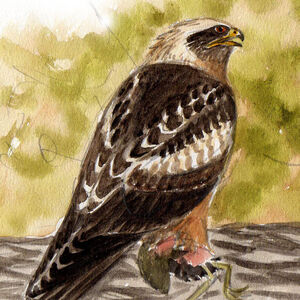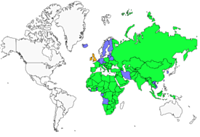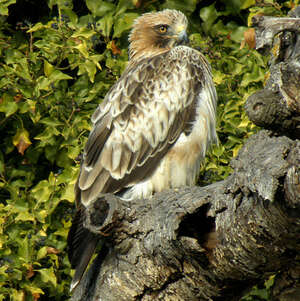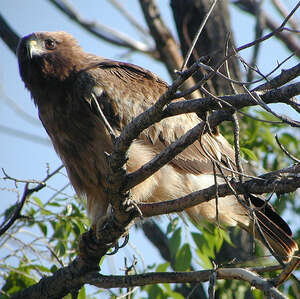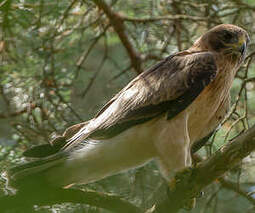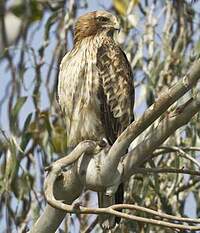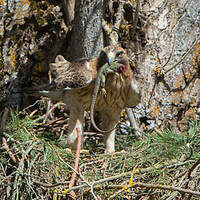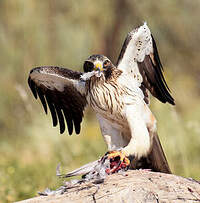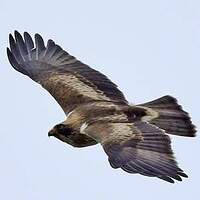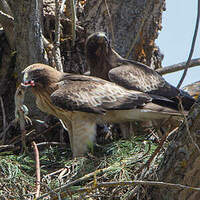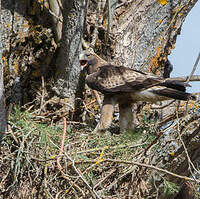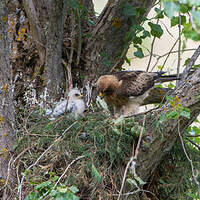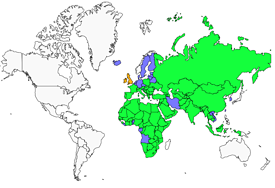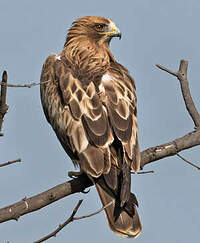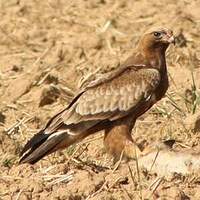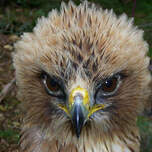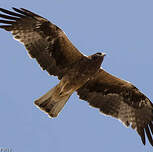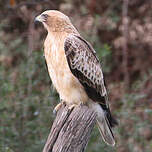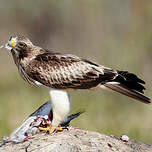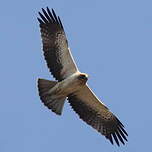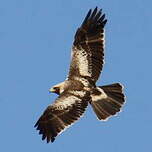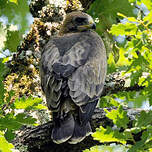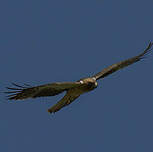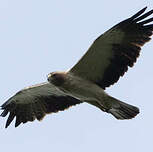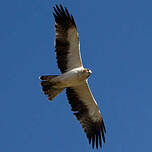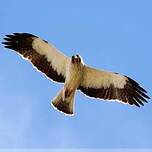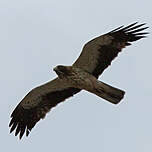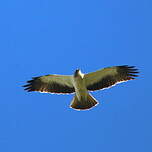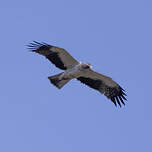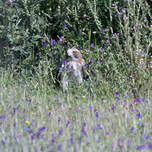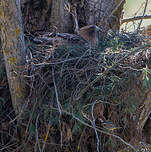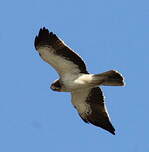Booted Eagle
Hieraaetus pennatus - Aigle botté
Identification
The Booted Eagle is a small eagle, about the same size as the Common Buzzard. It is already distinguished by its silhouette. The wings are longer, narrower, with parallel edges and especially six digitized flight feathers. The tail is longer, about equal to the width of the wing, and cut square at the end. The species is dimorphic. The pale phenotype is distinguished by its black and white appearance from below, with the flight feathers contrasting with the rest of the white plumage. The dark phenotype is entirely brown underneath, with the wing covers nevertheless paler than the flight feathers, a reddish brown. Always seen from below, the inner flight feathers are slightly transparent and form a bright panel in the hand against a clear sky. In the top view, the plumage pattern is typical and similar in both forms. Light beige zones strongly contrast with the dark background, especially the flight feathers and rump feathers in a V-shape. There is a specific diagnostic criterion, namely two small white spots at the attachment of the wing, commonly called position lights, very visible from the front. If the bird is perched, in addition to the above criteria, one should look at the tarsi that are feathered, like all eagles, and, on the pale form, darkly faced. The frequency of the dark morphotype seems to be increasing with latitude.
Subspecific information monotypic species
Foreign names
- Aigle botté,
- Águila calzada,
- águia-calçada,
- Zwergadler,
- törpesas,
- Dwergarend,
- Aquila minore,
- dvärgörn,
- Dvergørn,
- orol malý,
- orel nejmenší,
- Dværgørn,
- pikkukotka,
- Dwergarend,
- àguila calçada comuna,
- Skálmörn,
- orzełek (włochaty),
- pundurērglis,
- mali orel,
- Орёл-карлик,
- Elang setiwel,
- ヒメクマタカ,
- 靴隼雕,
- นกอินทรีเล็ก,
- 靴鵰,
Voice song and cries
The usual call is a repeated note, kih kih kih with a high pitch that is surprising coming from such a large bird. It would more likely be attributed to a falcon or a sparrowhawk. The Booted Eagle is particularly vocal at the time of the wedding parades in the sky. Apart from the breeding period, it is very quiet.
Habitat
The Booted Eagle is a forest dweller in breeding season. It inhabits both deciduous (oak and beech) forests and pine forests, on flatlands and on hilltops. The nest is built high up in a tree. Even though it often hunts in wooded areas, it still prefers to spot its prey in open areas, but the trees are never too far away. In the winter, it is less demanding and frequents all types of environments with trees like wooded savannahs.
Behaviour character trait
The Booted Eagle resides during the fair weather in territorial pairs. The couples come back year after year to the same nesting site and seem to be united for life.
In migration, it can form loose small groups before becoming quite solitary during wintering areas, but one can see small groups in favored environments.
It is a very skillful hunter, attacking large preys for its size. Despite its physical aptitudes, it seems to have never been used for falconry, probably because of an inadequate character.
Flight
The silhouette and type of flight are reminiscent of the Black Kite and confusion is possible when the latter is moulting from the tail. The Booted Eagle indeed glides with its wings slightly below the body plane, like a kite or a swallow. It is much more agile in flight than many other birds of its size and is capable of breathtaking dives. It is common to see it sharply dive into the canopy of the forest when hunting birds there, such as starlings or doves, for example.
Dietfeeding habits
Reproduction nesting
The nest is usually found in a tree, occasionally on a rocky face. It is built of branches by both adults at a height of 6 to 16 meters if it is on a tree.
Adults bring green leafy twigs during the entire nesting period, which makes the nest very typical.The female lays 1 to 3 white eggs, spotted with brown, in April-May. Incubation takes about 32 to 34 days, provided by the female fed by the male. She leaves the nest very little before hatching.
The chicks grow slowly and leave the nest at the age of 50 to 60 days. They still stay around the nest for a while, supplied by the parents.
Geographic range
The breeding range of the Booted Eagle is vast, stretching from middle latitudes of Spain and North Africa to the northeast of China. It will winter in Africa south of the Sahara, avoiding the compact forests of the west-centre, and in the Indian subcontinent. Thus, it is a great migrant. Migration is noted in March-April and September-October.
Threats - protection
IUCN conservation status
concern
in the Wild
threatened
evaluated
The species is classified as non threatened by BirdLife International. The population of Western Europe seems stable. Spain is the stronghold of the species. However, reductions in numbers or area restrictions have been reported. This is the case in France where the species still nested in the northeast in the first half of the 20th century. In this case, the causes of disappearance are probably multiple, but the direct destruction of birds and nests which was commonly practiced in the past in our country must be a major one. Nevertheless, population increases are also observed, which compensate for the decreases elsewhere. Overall, the species is not currently threatened.
Sources of information
- IOC World Bird List (v14.1), Gill, F and D Donsker (Eds). 2024-04-18.
Other sources of interest
 Specification sheet created on
22/07/2023 by Jean François
Specification sheet created on
22/07/2023 by Jean FrançoisTranslation by AI Oiseaux.net
published: 12-01-2001 - Updated: 25-02-2021
© 1996-2024 Oiseaux.net
- Accipitriformes
- Aegotheliformes
- Anseriformes
- Apodiformes
- Apterygiformes
- Bucerotiformes
- Caprimulgiformes
- Cariamiformes
- Casuariiformes
- Charadriiformes
- Ciconiiformes
- Coliiformes
- Columbiformes
- Coraciiformes
- Cuculiformes
- Eurypygiformes
- Falconiformes
- Galliformes
- Gaviiformes
- Gruiformes
- Leptosomiformes
- Mesitornithiformes
- Musophagiformes
- Nyctibiiformes
- Opisthocomiformes
- Otidiformes
- Passeriformes
- Pelecaniformes
- Phaethontiformes
- Phoenicopteriformes
- Piciformes
- Podargiformes
- Podicipediformes
- Procellariiformes
- Psittaciformes
- Pterocliformes
- Rheiformes
- Sphenisciformes
- Steatornithiformes
- Strigiformes
- Struthioniformes
- Suliformes
- Tinamiformes
- Trogoniformes

